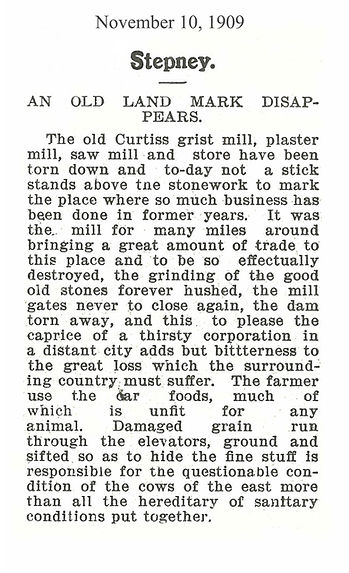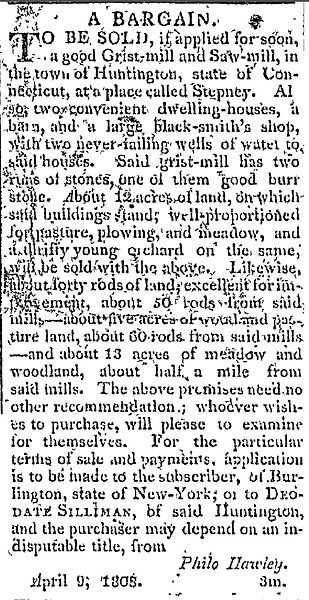Milling About Town
A Second Chapter - 1909
Back in 1909, a Bridgeport newspaper printed a rather scathing article, one decrying the demise of the mills at Stepney Depot, how they’d been senselessly razed in the name of alleged progress and how the modern “city” mills to replace them were producing a product so inferior that it wasn’t fit for consumption by man nor beast. It’s a rather grim and yet romanticized portrayal of the events of the day. But does it tell the entire story? No, it does not. Would you like to learn more? Ok. Let’s go back in time over a century ago and take a closer look.
The mills at Stepney Depot were established back in the 1700s, presumably by members of the Hawley family, who once owned large tracts of land on the western side of Monroe. First came the sawmill, required for processing lumber as the vast woodlands were cleared. And once successful crops were cultivated, the sawmill was followed by a gristmill to grind the harvested grain into meal and flour. By the end of the mills’ existence at Stepney Depot, there were saw, grist, plaster and bone mills, the latter to grind bones into bone meal which was used as an excellent fertilizer. All of the mills were powered primarily by the Western Branch of the Pequonnock River.
We can see in the supporting images that the mills were put up for sale as early as 1808 by Philo Hawley. Upper Stepney native, Captain Andrew Leavenworth, purchased and ran them successfully for decades. In 1840, during his later years, he sold a large share of the operation to a new resident named Barnum Curtiss, and when Leavenworth eventually passed in 1846, Curtiss purchased the balance of the milling enterprise from the surviving Leavenworth family.
Barnum Curtiss immediately invested heavily in improving the mills, and ever being the capitalist, he soon tried to sell them on for a profit. But when no suitable buyer could be found, he brought his son Andrew Barnum Curtiss into the business, and they ran the mills and a family mercantile together until Barnum’s death on Christmas day in 1891. His son Andrew carried on successfully with the operation until his death in 1909, the same year the attached article denounced the mills’ destruction. One of Monroe’s earliest and richest industrial eras was over - or so we thought.
In Stevenson, along our northernmost town border, a Canadian immigrant named Louis Goulett was well known in the district for making things happen. He was the postmaster and railroad stationmaster and was also the owner and proprietor of the general store which still stands at the sharp bend on Cottage Street. And if all of that weren’t enough, he also ran a successful feed mill beside the railroad’s sidetracks. He was a success by any definition, and it seemed as though nothing could go wrong, but he soon hit a streak of bad luck. In 1908 he lost both his barns to a fire caused by a lightning strike, followed shortly thereafter by the loss of his feed mill, also to fire.
These sequential fires were surely a devastating personal and financial blow, but Louis was a resilient and enterprising soul. He had a natural gift for recognizing an opportunity and always seemed to have the means in place to take advantage. Andrew Curtiss and Louis Goulett were both Freemasons and members of the Washington Lodge #19 at Monroe Center. When Andrew Curtiss passed in 1909, it was already known about town that no one within his family had an interest in carrying on the milling enterprise, which in large part was the primary reason for the mills’ demise. This was Goulett’s opportunity, and he approached Andrew’s widow with a business proposition.
He negotiated the purchase of Curtiss’s grist mill and mercantile building. He then hired a crew of workmen to dismantle the structures and move them up to Stevenson, presumably by rail, right to his front door to be reassembled and continue their long-standing tradition of milling. Of course, the Halfway, Housatonic and other local rivers were too far away to be options to power the relocated mill. Like his previous milling venture that burned the year prior, this reincarnation would be powered by gasoline engines. The business lasted only a year until 1910 when Louis Goulett passed away from an unexpected illness. His wife, Ella carried on in his stead, but in time sold off the family businesses to George Burr and Edward Twist.
So, as you can see, sometimes there’s far more to the story than what you may read in a single newspaper article. The mill and storehouse building stood beside the tracks up in Stevenson at least into the 1970s, but the story started near 7 miles southwest down at Stepney Depot. For those who are interested in such things, Louis and Ella Goulett are buried in the Bradley Family Cemetery just over the border in Newtown. We hope you found this little bit of Monroe milling history interesting. If so, please let us know. We always appreciate your feedback, and remember to keep your eyes open friends. Our past is always present.






